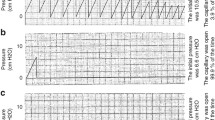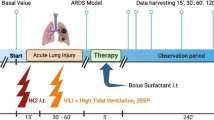Abstract
Lung-surfactant-deficient rabbits (n = 6) requiring artificial ventilation were subjected to a weaning-off regimen following surfactant replacement therapy. Surfactant-deficient rabbits (n = 6) that did not receive surfactant but underwent the same procedure served as controls. All surfactant-treated rabbits survived (i.e., reestablished spontaneous air breathing) whereas all the control animals died. In the surfactant-treated animals lung function improved in such a way that during the weaning period PaCO2 did not increase and the level of PaO2 remained significantly higher than in the control animals. The static lung compliance and the stability and expansion indices in vitro were significantly higher in the surfactant-treated rabbits. The lamellar body fraction of the lungs of surfactant-treated animals contained a significantly higher amount of surfactant phospholipids than those of the control animals.
It is concluded that the animal model used in this study is an excellent tool for testing early effects of different surfactant preparations.
Similar content being viewed by others
References
Adams FH, Tower B, Osher A, Ikegami M, Fujiwara T, Nozaki M (1978) Effects of tracheal instillation of natural surfactant in premature lambs. Pediatr Res 12:841–849
Bhagwani SL, Fahmy D, Turnbull AC (1972) Quick determination of amniotic fluid lecithin concentration for prediction of neonatal distress. Lancet 2:66–67
Clements JA, Hustead F, Johnson RP, Gribetz J (1961) Pulmonary surface tension and alveolar stability. J Appl Physiol 16:444–450
Duck-Chong CG (1978) The isolation of lamellar bodies and their membranous content from rat lung, lamb tracheal fluid and human amniotic fluid. Life Sci 22:2025–2030
Enhorning G, Hill D, Sherwood G, Cutz E, Robertson B, Bryan AC (1978) Improved ventilation of prematurely delivered primates following tracheal deposition of surfactant. Am J Obstet Gynecol 132:529–537
Ennema JJ (1985) Lung surfactant and respiratory support. Academic Thesis, University of Groningen, The Netherlands
Gruenwald P (1962) A numerical index of the stability of lung expansion. J Appl Physiol 18:6645–6667
Hamilton PP, Onayemi A, Smyth JA, Gillan JE, Cutz E, Froese AB, Bryan AC (1983) Comparison of conventional and high-frequency ventilation: oxygenation and lung pathology. J Appl Physiol 55:131–138
Ikegami M, Hesterberg T, Nozaki M, Adams FH (1977) Restoration of lung pressure-volume characteristics with surfactant: comparison of nebulization versus instillation and natural versus synthetic surfactant. Pediatr Res 11:178–182
Ikegami M, Jobe A, Duane G (1985) Liposomes of dipalmitoylphosphatidylcholine associated with natural surfactant. Biochim Biophys Acta 835:352–359
Jobe A, Ikegami M, Glatz T, Yoshida Y, Diakomanolis E, Padbury J (1981) Duration and characteristics of treatment of premature lambs with natural surfactant. J Clin Invest 67:370–375
Jobe A, Jacobs H, Ikegami M, Jones S (1983) Cardiovascular effects of surfactant suspensions given by tracheal instillation to premature lambs. Pediatr Res 17:444–448
Kobayashi T, Kataoka H, Ueda T, Murakami S, Tadaka Y, Kobkubo M (1984) Effects of surfactant supplement and end-expiratory pressure in lung lavaged rabbits. J Appl Physiol 57:995–1001
Lachmann B, Robertson B, Vogel J (1980) In vivo lavage as an experimental model of the respiratory distress syndrome. Acta Anaesth Scand 24:231–236
Nilsson R, Grossmann G, Berggren P, Robertson B (1981) Surfactant treatment in experimental hyaline membrane disease. Eur J Respir Dis 62:441–449
Reyngoud D-J, Ennema JJ, Egberts J, Wildevuur ChRH (1985) The composition of surfactant stored in type II pneumocytes is influenced by the composition of extracellular alveolar phospholipids. In: Ennema JJ (ed) Lung surfactant and respiratory support. Academic Thesis, University of Groningen. The Netherlands, pp 71–88
Touchstone JC, Chen JC, Beaver KM (1980) Improved separation of phospholipids in thin layer chromatography. Lipids 15:61–62
Young SL, Kremers SA, Apple JS, Crapo JD, Brumley LW (1981) Rat lung surfactant kinetics: biochemical and morphometric correlation. J Appl Physiol 51:248–253
Author information
Authors and Affiliations
Rights and permissions
About this article
Cite this article
Bambang Oetomo, S., Reijngoud, D.J., Ennema, J.J. et al. Surfactant replacement therapy in surfactant-deficient rabbits: Early effects on lung function and biochemical aspects. Lung 166, 65–73 (1988). https://doi.org/10.1007/BF02714030
Accepted:
Issue Date:
DOI: https://doi.org/10.1007/BF02714030




